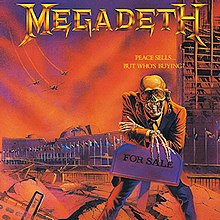| Peace Sells... but Who's Buying? | ||||
|---|---|---|---|---|
 Cover art by Ed Repka | ||||
| Studio album by | ||||
| Released | September 19, 1986 | |||
| Recorded | February–March 1986 | |||
| Studio |
| |||
| Genre | ||||
| Length | 36:12 | |||
| Label | Capitol | |||
| Producer |
| |||
| Megadeth chronology | ||||
| ||||
| Singles from Peace Sells... But Who's Buying? | ||||
| ||||
Peace Sells... but Who's Buying? is the second studio album by American thrash metal band Megadeth, released on September 19, 1986, through Capitol Records. The project was originally handled by Combat Records, resulting in the original mix of the album being co-produced by Randy Burns. Capitol Records then bought the rights to the album and hired another producer named Paul Lani to mix it himself. The recording of the album was difficult for the band, because of the ongoing drug issues the members had at the time. Drummer Gar Samuelson and guitarist Chris Poland were fired shortly after the album's promotional tour for drug abuse, making Peace Sells Samuelson's last Megadeth album. Poland reappeared as a session musician on Megadeth's 2004 album The System Has Failed. The title track, noted for its politically conscious lyrics, was released as the album's second single and was the band's first music video. The album's cover art, featuring the band's mascot Vic Rattlehead in front of a desolated United Nations Headquarters, was created by Ed Repka.
Peace Sells... but Who's Buying? is often regarded as a thrash metal classic and as an album that gave prominence to extreme metal. It has been featured in several publications' best album lists, including Robert Dimery's 1001 Albums You Must Hear Before You Die and Martin Popoff's Top 500 Heavy Metal Albums of All Time. The album has been reissued several times over the years. In 2004, the album was remixed and remastered by Megadeth frontman Dave Mustaine, with extensive liner notes detailing the album's background. In 2011, the three different versions were reissued as part of the album's 25th anniversary celebration. All of them, with the exception of the 2004 mixes, feature new remastering.
- ^ "The 25 greatest thrash metal albums ever". Kerrang!. Retrieved August 15, 2021.
- ^ "20 Essential Eighties Thrash Albums". Revolver. April 1, 2007. Retrieved August 15, 2021.